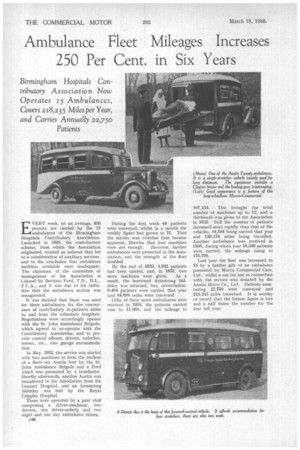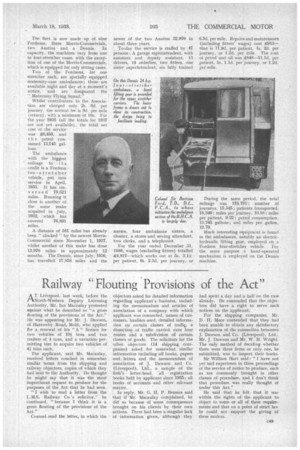Ambulance Fleet Mileages Increases 250 Per Cent. in Six Years
Page 86

Page 87

If you've noticed an error in this article please click here to report it so we can fix it.
Birmingham Hospitals Contributory Association Now Operates 15 Ambulances, &Men 218,235 Miles per Year, and Carries Annually 22,750
Patients
EVERY week, on an average, 436 persons are carried by the 15 ambulances of the Birmingham Hospitals Contributory Association. Launched in 1928, the contributory scheme, from which the Association originated, created an interest that led to a consideration of auxiliary services, and to the conclusion that ambulance facilities available were inadequate. The chairman of the committee of management of the Association is Colonel Sir Bertram Ford, T.D., DL., F.C.A., and it was due to his initiative that the ambulance section was inaugurated.
It was decided that there was need for three ambulances for the conveyance of contributory in-patients alone to and from the voluntary hospitals. Negotiations were accordingly opened with the St. John Ambulance Brigade, which agreed to co-operate with the Contributory Association, and to provide control officers, drivers, orderlies, muses, etc., also garage accommodation.
In May, 1932, the service was started with two machines to form the nucleus of a fleet—an Austin lent by the St. John Ambulance Brigade and a Ford which was presented by a benefactor. Shortly afterwards, another Austin was transferred to the Association from the General Hospital, and an Armstrong Siddeley was lent by the Royal Cripples Hospital.
These were operated by a paid staff comprising a driver-mechanic, two drivers, one driver-orderly and two night and one day ambulance sisters.
c49 During the first week 44 patients were conveyed, whilst in a month the weekly figure had grown to 75. That the service was overdue thus became apparent, likewise that four machines were not enough. However, further ambulances were presented to the Association, and the strength of the fleet doubled.
By the end of 1932, 3,922 patients had been carried, and, in 1933, two more machines were given. As a result, the borrowed Armstrong Siddeley was returned, but, nevertheless, 9,404 patients were carried that year and 84,688 miles were traversed.
Gifts of three more ambulances were received in 1934, the patients carried rose to 11,064, and the mileage to
107,154. This brought the total number of machines up to 12, and a thirteenth was given to the Association in 1935. Still the number of patients increased.more rapidly than that of the vehicles, 14,584 being carried that year and 139,174 miles being travelled. Another ambulance was received in 1936, during which year 18,349 patients were carried, the mileage rising to 175,791.
Last year the fleet was increased to 15 by a further gift of an ambulance presented by Morris Commercial Cars, Ltd., whilst a car for use in connection with the service was donated by the Austin Motor Co., Ltd. Patients numbering 22,750 were conveyed and 218,235 miles traversed. It is worthy of record that the former figure is two and a half times the number for the first full year. The fleet is now made up of nine Fordsons, three Morris-Commercials, two Austins and a Dennis. In capacity, the machines vary from one to four-stretcher cases, with the exception of one of the Morris-Commercials., which is equipped for only sitting cases.
Two of the Fordsons, for one stretcher each, are specially equipped maternity-case ambulances; these are available night and day at a moment's notice, and are designated the 'Maternity Flying Squad."
Whilst contributors to the Association are charged only 2s. 6d. per journey, the normal fee is 9d. per mile (return), with a minimum of 10s. For the year 1936 (all the totals for 1937 are not yet available), the total net cost of the servicewas 46,456, and t h e petrol consumed 13,745 gallons.
The ambulance with the biggest mileage to i t a credit is .a Fordson two vehicle, put into service in April, 1933. It has tra versed 79,521 miles. Running it . close is another of the same make acquired in July, 1932, which has • covered 76,891 miles.
A distance of 581 miles has already beep " clocked " by the newest MorrisCommercial since November 1, 1937, whilst another of this make has done 13,970 miles in approximately 12 months. The Dennis, since July, 1936, has travelled 17,858 miles and the newer of the two Austins 32,970 in about three years.
• To-day the service is staffed by .47 persons: A garage superintendent, with assistant and deputy assistant, 13 drivers, 13 orderlies, two fitters, one sister superintendent, six fully trained
nurses, four ambulance sisters, a cleaner, a stores and sewing attendant, two clerks, and a telephonist.
For the year ended December 31, 1956, wages (excluding fitters) totalled -44,817—which works out at 5s. 3.1d. per patient, 6s. 2.3d. per journey, or 6.5d. per mile. Repairs and maintenance (including fitters' wages) cost £913— that is 11.9d. per patient, Is. 2d. per journey, or 1.2d. per mile'. The cost of petrol and oil was R,848-11.1d. per patient, 1s, 1.1d. per journey, or 1.2d, per mile.
During the same period, the total mileage was 175.791; number of journeys, 15,345; patients transported, 18,349; miles per journey, 10.88: miles per patient, 9.22; petrol consumption, 18,745 gallons ; and miles per gallon, 12.79.
Much interesting equipment is found in the ambulances, notably an electrichydraulic lifting gear, employed on a Fordson four-stretcher vehicle. For the same purpose • a hand-operated mechanism is employed on the Dennis machine.












































































































































